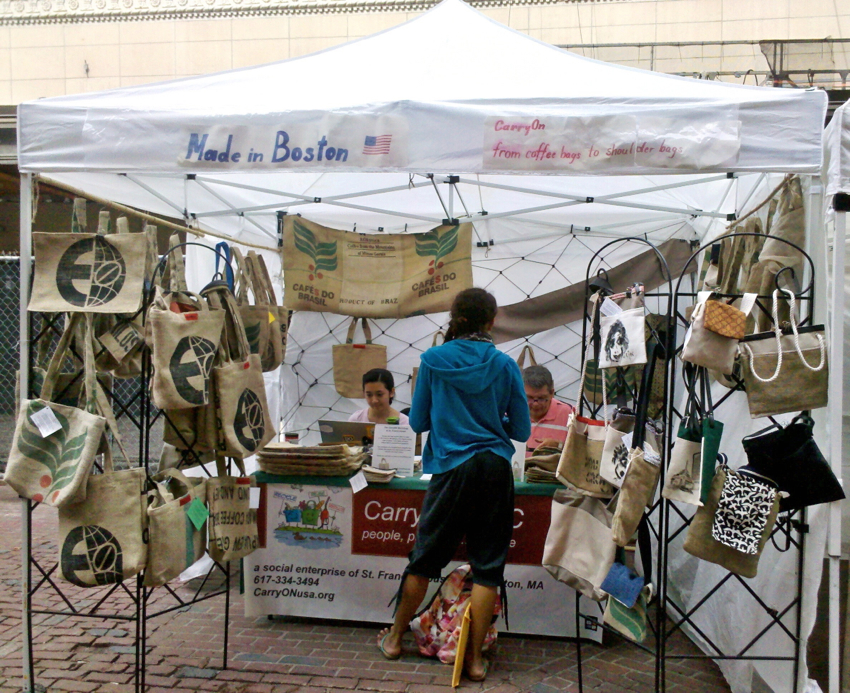This New Venture Gets Homeless People Back To Work

Photo by Patricia Guiao
For homeless men and women with a history of incarceration who want to break away from government handouts, there’s CarryON, a new business that employs guests of St Francis House. They create artistic carryalls out of repurposed materials that would otherwise be thrown away, namely burlap coffee bags and awning canvas.
CarryON recently launched a crowdfunding campaign to build their business and have opened their doors to the public at the Summer Street Art Market at Downtown Crossing on Mondays and Wednesdays into September. We caught up with Fred Smith, one of the project’s founders and the Development Director of St Francis House, whose mission is to provide skills and job opportunities to the homeless.
What was the impetus for the idea behind CarryON?
A group of three or four ex-offenders—homeless guys—with backgrounds that prevented them from gaining employment came to me. They wanted to work and be productive. I said, what if I acquired a sewing machine and you guys learned how to sew? There might be some work for you, I told them. I did have a big vision, but I wanted these guys to take ownership and feel the pride that they were building something. The ultimate goal is for CarryON to be turned over to the guys as their own business.
Who is in the business?
Right now, 10 men and women are in various parts. Five guys are regular stitchers who fabricate the bags. We take discarded burlap coffee sacks, canvas materials, and surplus canvas from an awning company and other remnant fabrics and we then put together the bags. One of the issues is handles—leather is too expensive—and so two or three guys are learning the inkle loom. We have a small workshop at St. Francis House with three looms where they make straps. [We] haven’t manufactured any yet but we are in the process of doing so. One woman involved isn’t well enough to sew but she is creating designs and putting them on small postcards and we will be incorporating the designs in the bags.
How are the bags put together?
When we get a load of canvas coffee bags, we have to cut them open. Some guys cut and some guys sew. The graphics for these are already on the bag. The designs on the Copley bags also use St. Francis House artists, Dante and Efon, who are both well-known street artists in downtown Boston. We also get some patterns from Pat Gorham at Savorii.com, a schoolteacher/inventor/designer who designed some of the Copley bags.
Tell me about the men and women who are involved in the business.
Only one lives at St. Francis House and the rest are homeless and have had involvement with crime but are trying to never go back to prison or rely on the government for handouts.
What makes you want to do this work?
I have been at Francis House for 18 years and started the Moving Ahead Program, which is a life-skills and career development program for homeless people, and as I did that, I was drawn to the guys and the women who were the most difficult to serve.
I’ve always thought that, if you were in this business, you should be working with the most challenging and not the easiest people—that is, in terms of the issues that they present. Society doesn’t easily let them enter the mainstream. I have adopted several children from families similar to those I serve. My children are a great motivator.
One example that sent me down this particular path: There was a gentleman who came in to see me and he was looking for work. He had a dozen certificates—everything from cleaning to culinary arts—so what’s the problem, I asked? He said, “I don’t have a job.” All these non-profits get money to train people, and you know what? We can’t just keep recycling people through the system.
What is St Francis House’s involvement?
St Francis House has supported this effort and helped us form a Limited Liability Corporation—separate but owned by St Francis House, a non-profit. People who donate can get a tax write-off. I have a lot of business that I could do with more space. The dream is to form a company and employ people, replicate this all across the country [because] everywhere there are people outside of the mainstream.

